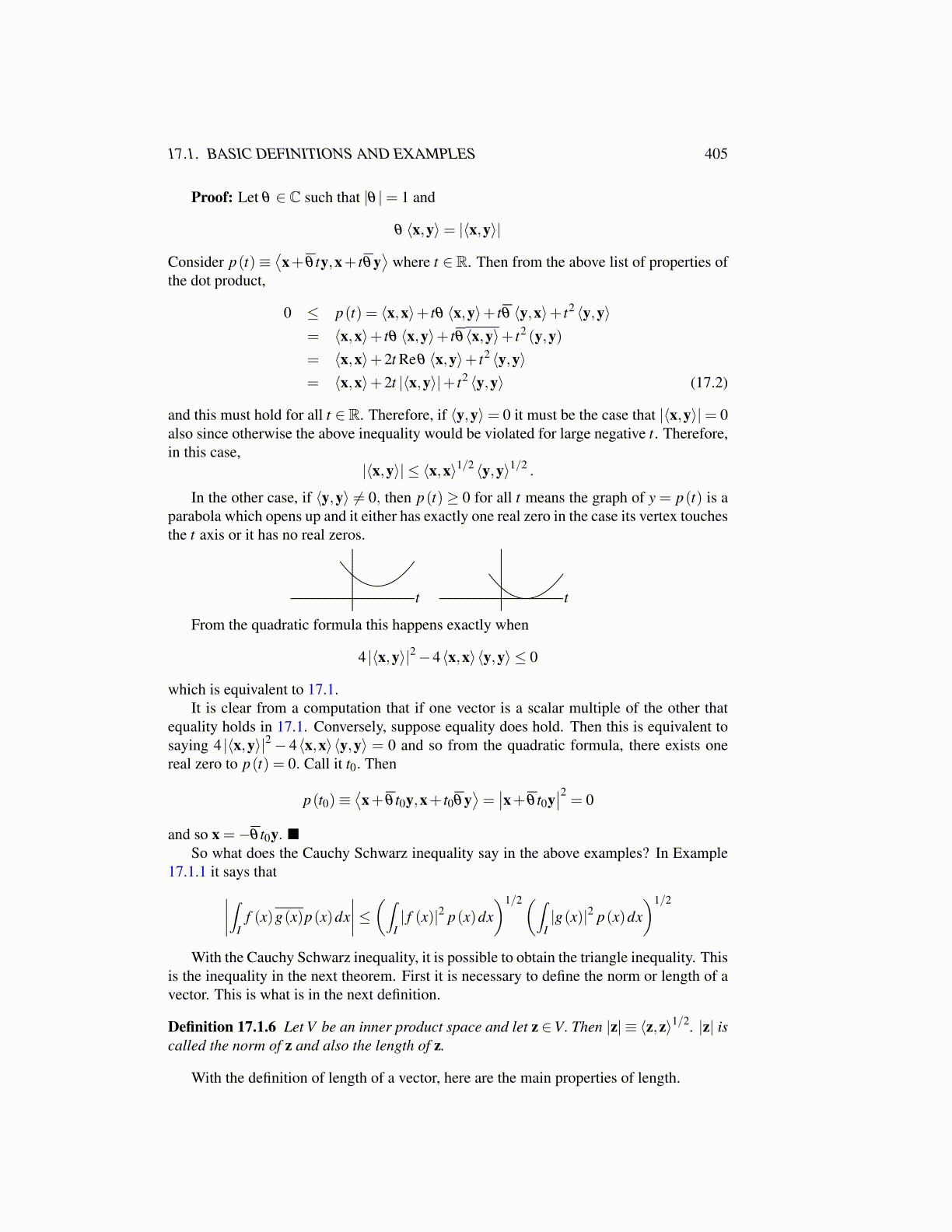
17.1. BASIC DEFINITIONS AND EXAMPLES 405
Proof: Let θ ∈ C such that |θ |= 1 and
θ ⟨x,y⟩= |⟨x,y⟩|
Consider p(t)≡⟨x+θ ty,x+ tθy
⟩where t ∈ R. Then from the above list of properties of
the dot product,
0 ≤ p(t) = ⟨x,x⟩+ tθ ⟨x,y⟩+ tθ ⟨y,x⟩+ t2 ⟨y,y⟩= ⟨x,x⟩+ tθ ⟨x,y⟩+ tθ⟨x,y⟩+ t2 (y,y)= ⟨x,x⟩+2t Reθ ⟨x,y⟩+ t2 ⟨y,y⟩= ⟨x,x⟩+2t |⟨x,y⟩|+ t2 ⟨y,y⟩ (17.2)
and this must hold for all t ∈R. Therefore, if ⟨y,y⟩= 0 it must be the case that |⟨x,y⟩|= 0also since otherwise the above inequality would be violated for large negative t. Therefore,in this case,
|⟨x,y⟩| ≤ ⟨x,x⟩1/2 ⟨y,y⟩1/2 .
In the other case, if ⟨y,y⟩ ̸= 0, then p(t)≥ 0 for all t means the graph of y = p(t) is aparabola which opens up and it either has exactly one real zero in the case its vertex touchesthe t axis or it has no real zeros.
t t
From the quadratic formula this happens exactly when
4 |⟨x,y⟩|2−4⟨x,x⟩⟨y,y⟩ ≤ 0
which is equivalent to 17.1.It is clear from a computation that if one vector is a scalar multiple of the other that
equality holds in 17.1. Conversely, suppose equality does hold. Then this is equivalent tosaying 4 |⟨x,y⟩|2− 4⟨x,x⟩⟨y,y⟩ = 0 and so from the quadratic formula, there exists onereal zero to p(t) = 0. Call it t0. Then
p(t0)≡⟨x+θ t0y,x+ t0θy
⟩=∣∣x+θ t0y
∣∣2 = 0
and so x =−θ t0y. ■So what does the Cauchy Schwarz inequality say in the above examples? In Example
17.1.1 it says that∣∣∣∣∫If (x)g(x)p(x)dx
∣∣∣∣≤ (∫I| f (x)|2 p(x)dx
)1/2(∫I|g(x)|2 p(x)dx
)1/2
With the Cauchy Schwarz inequality, it is possible to obtain the triangle inequality. Thisis the inequality in the next theorem. First it is necessary to define the norm or length of avector. This is what is in the next definition.
Definition 17.1.6 Let V be an inner product space and let z ∈V. Then |z| ≡ ⟨z,z⟩1/2. |z| iscalled the norm of z and also the length of z.
With the definition of length of a vector, here are the main properties of length.